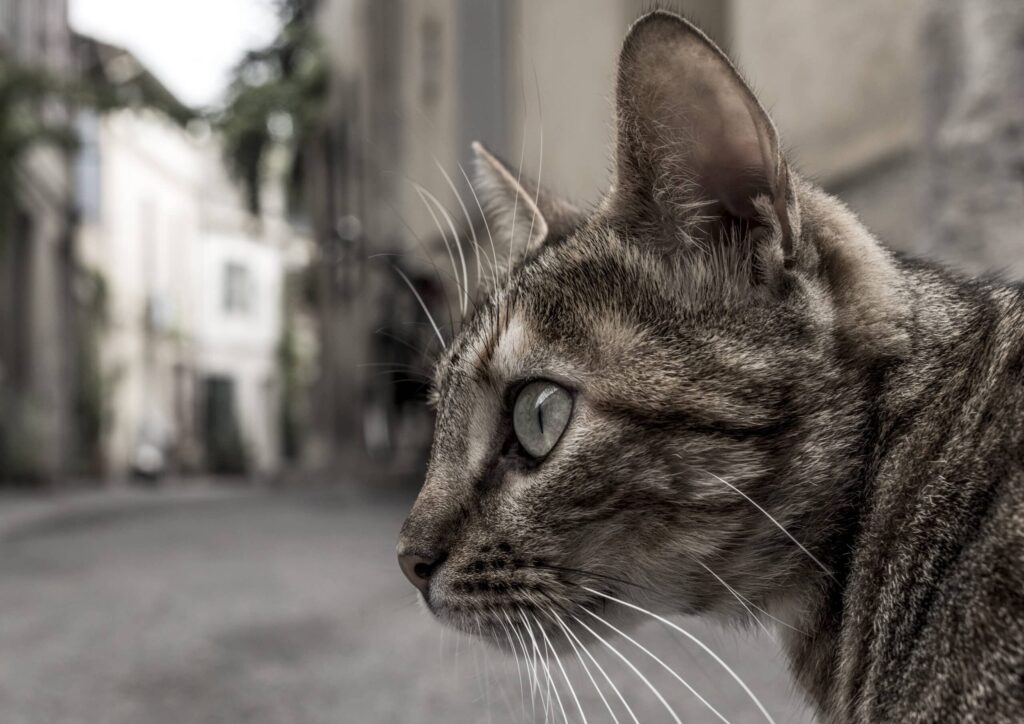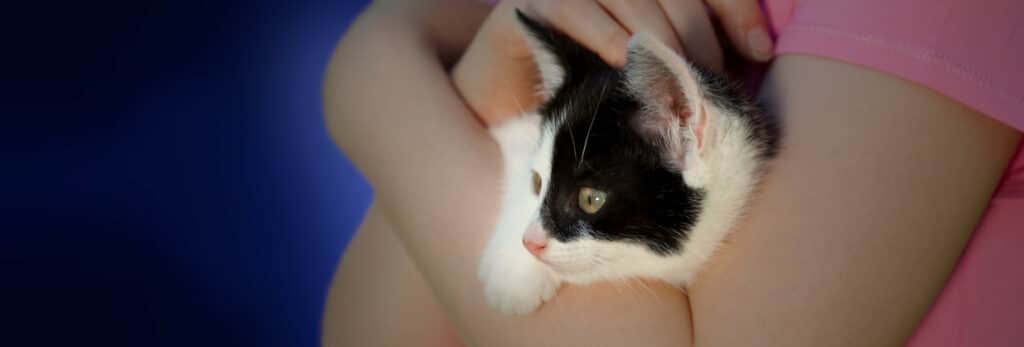
Decoding Feline Body Language
Cats are masters of communication and use a nuanced and intricate system of feline body language to express their emotions, intentions, and needs. This article explains how to decode and understand what our furry friends have to say.
Learning to interpret feline body language is the key to developing a deep connection with your cat. This deep dive into the fascinating world of feline body language explores notable differences between healthy, sick, and mentally distressed cats.
The valuable information in this article can even help you spot health issues early.
Best of all, decoding feline body language is a skill that improves your ability to manage your cat’s well-being and enriches the bond between you.
Please Note: CatInfo.net has created a cat body language chart showing twelve common feline body language postures.
Feline Body Language in a Healthy Cat
Your cat certainly can’t speak English, but that doesn’t mean it’s unable to communicate with you. Cats have a number of methods they use to reveal their thoughts, emotions, and intentions to others.
Learning to “read” your cat’s inner world via its body language unlocks a wealth of information about its health and mental state. In this section, we’ll focus on the body language of a healthy cat.
Tail Talk
A cat’s tail is a versatile communication tool and offers useful insights into its mood. The very first thing every cat owner should do is learn to read their feline’s tail.
Your cat is content and confident when held upright with a relaxed curve at the tip. This posture indicates a happy and approachable attitude.
Conversely, a puffed-up tail signifies fear or agitation, as the cat tries to appear larger in the face of a perceived threat. Approaching a cat in this state will likely result in a claw-infested swipe or a needle-sharp bite!
Expressive Ears
The position of a cat’s ears provides significant clues about its emotional state. It’s worth paying attention to your cat’s ears before you extend your hand to stroke it.
Ears held forward and upright suggest curiosity and engagement. If your cat’s ears are flattened against its head, it shows fear, aggression, or annoyance.
Understanding these cues allows you to gauge your cat’s receptiveness to interaction.
Eye Contact
Like humans, cats communicate through their eyes. A slow blink from your cat is a sign of trust and affection. And when you reciprocate with a slow blink of your own, you strengthen your mutual bond.
When a cat’s pupils are dilated, it indicates excitement or interest. But narrowed pupils tend to signal aggression or unease. Watch out because it may indicate an incoming swipe!
Posture
A relaxed, sprawled-out position in your presence indicates comfort and ease. Cats that stretch and expose their bellies demonstrate trust and vulnerability. But please note, unlike dogs, cats that expose their belly aren’t inviting you to rub.
A hunched or crouched stance may indicate defensiveness or caution but this does depend on the situation. If your cat is hunting, a crouched stance signifies preparation to strike!
Vocalization
Healthy cats vocalize for various reasons, and their body language normally complements the sounds they’re producing.
A cheerful meow accompanied by an upright tail showcases contentment, whereas a low-pitched growl with a puffed tail may indicate displeasure.
Playfulness
Healthy cats are often inquisitive and playful. If they engage in play behaviors like chasing toys, pouncing, and stalking, it’s a sign of their physical and mental well-being. You can help engage your cat’s natural desire to play by providing interactive toys.
As your cat ages, its desire to play will subside. Don’t be too concerned if your 22-year-old cat prefers to snooze under a sunny window rather than chance a mouse on a string!
Summing up Feline Body Language in a Healthy Cat
Decoding the body language of a healthy cat is an art that brings you closer to your feline companion’s world. Tail positions, ear orientations, eye contact, and posture all contribute to a silent but eloquent dialogue between you and your cat.
Recognizing these cues will build trust, strengthen your relationship, and improve your cat’s happiness. Every cat has a unique personality, so take the time to learn and appreciate your furry friend’s individual signals.
Healthy
The body language of healthy cats is often easy to decode. The key to detecting physical and mental health issues is looking for changes.
Illness
When a cat is physically unwell, it often
“signals” the fact via subtle changes in its body language. This can help you detect illness early.
Anxiety
A cat suffering from mental distress may express it by hiding, avoiding contact, aggressive behavior, thrashing its tail, and excessive grooming.
Body Language in Sick Cats
Because cats are masters of suppression, it can sometimes be difficult to tell when your cat is ill. Fortunately, your cat’s body language will change and provide subtle clues to their discomfort.
Deciphering these signs is crucial for ensuring timely medical attention and providing the best care possible.
Lethargy and Withdrawal
A telltale sign of a sick cat is a sudden lack of energy and enthusiasm. If your once-playful feline companion becomes lethargic, sleeps more, and is less interested in its usual activities, it’s an indicator that something may be amiss.
If your cat enjoys a cuddle or sitting on your lap, illness may result in it avoiding such interaction. A sick cat might also seek a quiet, isolated spot to rest. A cat that never hides may start hiding in a closet, under the bed, or seek a secluded garden spot.
Eating Habits
A significant shift in appetite, whether it’s a sudden loss of interest in food or an unusually ravenous appetite, can indicate an underlying health issue.
Pay attention to your cat’s eating habits, and if you notice a persistent change, it’s time to consult a veterinarian.
Grooming Behavior
Cats are meticulous groomers, and changes in their grooming routine can be a sign of illness. A sick cat might groom excessively, attempting to comfort themselves.
Alternatively, you may notice your cat’s coat starts to look shabby. This can result from neglected grooming due to discomfort or an illness affecting skin and/or fur.
Vocalization
Cats vocalize for various reasons, and changes in their vocal patterns may signal discomfort or illness. A cat meowing more than usual may signal a health issue. Likewise, you should investigate further if its vocalizations sound strained, weak, or distressed.
If you have any concerns, especially if changes to vocalization occur in conjunction with other changes in behavior, consult your veterinarian.
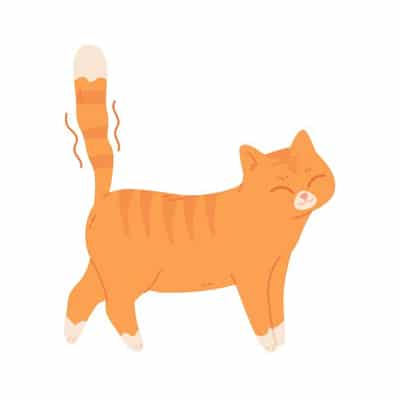
Tail Quivering
Delighted to see you!
When your cat approaches you with its tail straight up and quivering, it tells your cat is happy to see you.

Leg Rubs
You’re mine. I’m yours.
A cat that rubs its body and cheeks against your legs is telling you that you belong to it, and it belongs to you.
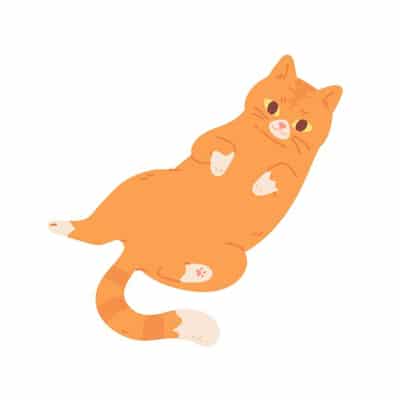
Exposing Belly
I trust you.
A cat that lies on its back and exposes its billing is saying, “I trust you.” But be warned; this isn’t an invitation to rub its belly.
Posture and Movement
Observe how your cat holds itself and moves. A hunched posture, stiffness, or difficulty walking can all point to physical discomfort. Reluctance to jump, play, or climb may also indicate pain or illness.
If you have stairs, and your cat is suddenly reluctant to travel up or down them, this may signal pain or a lack of energy. Watch your cat as it goes up and/or down the stairs, and look for changes to its gait.
Eye and Nose
Watery or runny eyes and excessive sneezing or nasal discharge may signal an upper respiratory infection or another underlying issue. Monitor any changes in your cat’s eyes and nose closely.
Cat flu brings on similar symptoms in your feline as human flu does in you. A healthy cat is unlikely to die from the flu, but it can be fatal in an elderly cat or one with underlying health issues. If you have any concerns, call your veterinarian.
Behavioral Changes
A sick cat might exhibit changes in behavior, such as increased irritability or aggression. They may become more sensitive to touch and shy away from petting due to discomfort.
Healthy cats already sleep most of the day, but if you notice your cat sleeping when they would normally be active, it may be a sign of illness. Conversely, if your cat suddenly starts sleeping less, it could be a symptom of a serious health issue.
Conclusion to Body Language in Sick Cats
Understanding the body language of a sick cat is an essential skill for every cat owner. By recognizing these subtle cues, you can give your feline friend the care and attention they need when they’re not feeling their best.
If you notice any of these signs persisting or worsening, it’s vital to seek professional veterinary advice promptly. Early detection and intervention can significantly impact your cat’s well-being and recovery.
Remember, your cat’s well-being is your priority, and being attuned to their body language is a key element of responsible pet ownership.
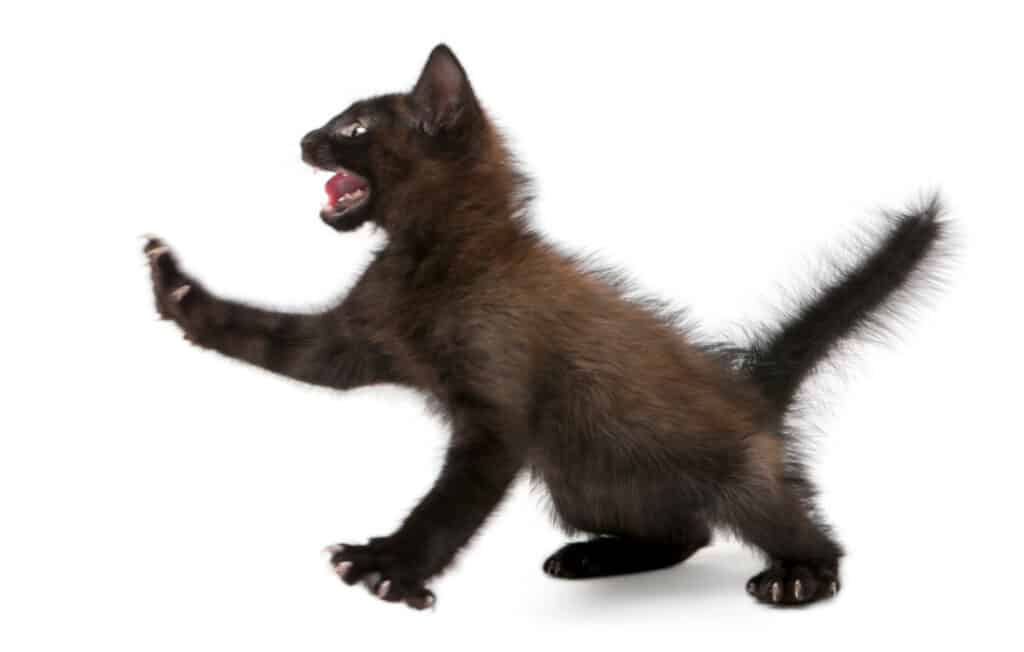
Feline Body Language in Anxious Cats
All cats convey their emotional state through subtle yet telling body language. When a cat is experiencing mental distress, their behavior provides crucial insights into their mental state.
As a responsible cat owner, it’s essential that you recognize these signs and take appropriate steps to alleviate their anxiety. The following is a guide to decoding the feline body language of a mentally distressed cat.
Tail Behavior
One of the most revealing indicators of a cat’s emotional state is its tail. Anxious cat might display agitated tail movements, such as rapid twitching or lashing.
Abrupt tail motions signify anxiety, apprehension, or feeling threatened. All cats exhibit this behavior when aggravated or in fear, but a mentally distressed cat may exhibit this behavior constantly.
Conversely, a tucked or lowered tail can indicate submission or fear. If your cat frequently exhibits such behavior without obvious cause, it’s worth contacting your veterinarian.
Hiding and Avoidance
When a cat is anxious, it may retreat to secluded areas of the home. Hiding under furniture, in closets, or in other inaccessible spots is a defense mechanism that helps them cope with their anxiety.
If your usually sociable cat suddenly avoids interaction and seclusion turns into a habit, it’s time to investigate potential sources of distress.
Excessive Grooming
Grooming is a normal behavior for a cat and isn’t a cause for concern. Excessive licking or chewing on fur can be a sign of mental distress. This behavior, known as psychogenic alopecia, is often triggered by anxiety and can lead to bald patches or irritated skin.
Excessive grooming may also indicate a skin disorder or other physical illness. That’s why it’s essential that you consult your veterinarian to obtain a correct diagnosis.
Appetite
Just like humans, cats’ eating habits are influenced by their emotional well-being. Anxiety can lead to appetite changes, causing your cat to either lose interest in food or overeat.
Monitor your cat’s eating patterns closely. If you notice significant changes, consult a veterinarian.
Aggression
A mentally distressed cat might exhibit aggression towards people, other animals, or even inanimate objects. Outbursts like this are an attempt to assert control in their environment that arise from heightened stress levels.
Please call your veterinarian if you notice your cat has started overreacting to stimuli, especially if it’s reacting to inanimate objects.
New Vocalizations
Unusual vocalization, such as excessive meowing or growling, can indicate that your cat is experiencing emotional turmoil. The pitch and frequency of their sounds can provide insights into their state of mind.
Please call your veterinarian if your cat produces new vocalizations, especially in combination with other behavioral changes.
Seeking Professional Help
If you notice persistent signs of mental distress in your cat, seeking professional advice is paramount. Consulting a veterinarian or an animal behaviorist can help pinpoint the root cause of the anxiety and provide tailored solutions to improve your cat’s well-being.
CatInfo.net recommends you include your veterinarian even if you suspect mental distress rather than a physical illness. That way, your vet can rule out physical illness as the underlying cause of anxiety.
Summarizing Feline Body Language in Mentally Destressed Cats
If you suspect that your feline friend is experiencing mental distress, pay close attention to their…
- Tail behavior.
- Hiding tendencies.
- Grooming habits.
- Changes to appetite.
- Aggression.
- Vocalizations.
By identifying these signs early and taking appropriate action, you can help your cat feel more secure and content, fostering a harmonious bond between you and your beloved companion.

Purring and Body Language
Most cat owners know their cat purrs when it’s happy. But feline purring doesn’t always mean a cat is in a state of bliss.
A cat may also purr when it’s injured or suffering anxiety. This type of purring is thought to occur when a cat wants to calm itself down or as an aid to healing.
You can tell the difference by considering your cat’s body language. Signs of physical illness or emotional stress combined with purring indicate your cat has a problem.
If your cat takes shallow breaths or is breathing rapidly, that could be a sign of physical pain. Your best tactic in this situation is to phone your veterinarian.
Conclusion to Decoding Feline Body Language
The body language of domestic house cats is a rich and intricate form of communication that reflects their emotions, health, and mental state. As a responsible cat owner, it’s your duty to understand and interpret these cues to provide the best care and support for your cat.
You can gain insight into your cat’s feelings and needs by observing tail positions, ear orientations, eye contact, posture, and other subtle cues.
Whether they’re healthy, sick, or experiencing emotional distress, paying attention to behavior and body language changes can help you address their needs promptly and effectively.
And always consult a veterinarian when concerned about your cat’s health or well-being.
Every cat is unique and their body language might vary based on their personality and past experiences. The more you engage with your cat and learn to recognize its signals, the stronger the bond between you will become.
Remember to print the CatInfo.net cat body language chart showing twelve different feline body language postures.

